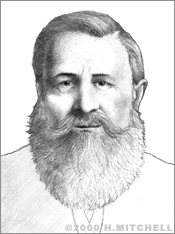Isaac Singer
Isaac Merrit Singer developed the first commercially successful sewing machine. Born in 1811 in Pittstown, New York, Singer spent much of his youth devoted to acting. At age 38, when his career in show business proved unsuccessful, Singer settled in New York to focus on inventing full-time.
Singer had always possessed an exceptional aptitude for all things mechanical. At the age of 19 he worked as an apprentice machinist, and in 1839 he patented a rock-drilling machine while working with an older brother to help dig the Illinois waterway. Ten years later he patented a metal- and wood-carving machine.
While working in a Boston machine shop in 1850, Singer was asked to repair a Lerow and Blodgett sewing machine; just a few days later he had designed and built an improved model. Singer's version of the sewing machine was the first to allow to continuous and curved stitching, with overhanging arm that held the needle bar over a horizontal table. This design made it possible to sew on any part of the work. Motion was communicated to the needle arm and shuttle by means of gears.
At first, Singer's sewing machine didn't sell. Priced at over $100, the machine proved far too expensive for the average American household. Husbands generally controlled the family purse strings at the time, and most of them saw no need to spend money on a labor-saving device for making clothing their wives already made with a needle and thread. There was no market for the machine in the garment industry either, where workers labored long hours with little pay.
Soon, as a result of the industrial revolution, interchangeable parts could be tooled by expert craftsmen to within an accuracy of one-sixteenth of an inch. Firemarms makers, however, wanted more. Gunmakers soon set out developing machine tools, gauges, and milling cutters capable of manufacturing parts to one-thousandth, then one one-ten-thousandth of an inch.
Isaac Singer, even though his early total sewing machine production and profit margins remained modest, saw the real potential in transferring Samuel Colt's hand-gun manufacturing techniques to the production of Singer sewing machines. He decided to invest heavily in machinery designed to mass-produce sewing machines with interchangeable parts.
In late 1857, Singer opened the world's first mass production facility for something other than firearms in New York. I.M. Singer & Company was soon able to cut production costs to a little more than $10 per machine. Singer sold his new machines for 50% less than his first machine, yet had increased his profit margin to 530% per machine. In 1858, Singer opened three more New York-based manufacturing plants and unit sales topped 3,000 per year.
In 1863 Singer and his business partner Edward Clark incorporated the Singer Manufacturing Company, holding 22 patents with capital assets of $550,000. Singer retired in England. With the opening of the first foreign factory, near Glasgow in 1867, the company became a world-wide success.
It is important to note that in 1850, the idea of a sewing machine was nothing new. The first patents for such a machine had been granted in England in 1790, in Austria in 1819, the U.S. in 1826 and France in 1830.
A similar machine had been patented by the American inventor Elias Howe in 1846. Howe brought suit against Singer for patent infringement and won, forcing Singer to pay royalties. Singer continued his efforts, however, and by 1860 he had become the largest manufacturer of sewing machines in the world. His basic design features have been followed in almost all subsequent machines.
Singer died a wealthy man in 1875, at the Wigwam, his British estate.


